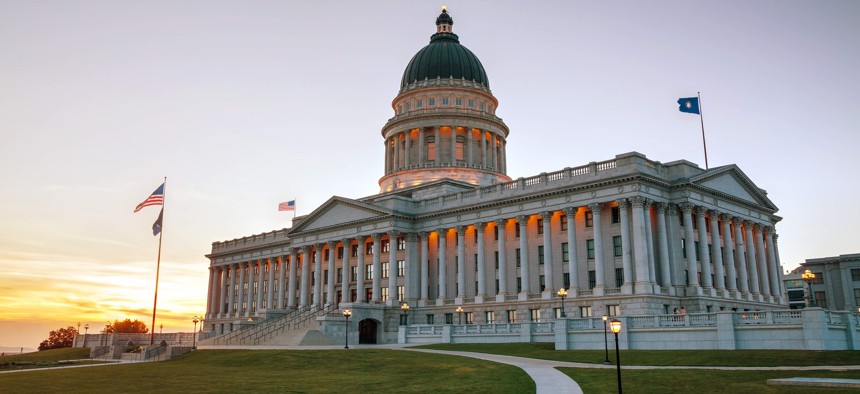With Healthy Budgets, Dozens of States Give Raises to Their Workers

The Utah state capitol in Salt Lake City. Utah was one of at least 37 states that provided pay raises to public employees in fiscal year 2020. Shutterstock

Connecting state and local government leaders
The number of states bumping up pay for their employees has hit a high not seen since prior to the Great Recession.
Thirty-seven states in fiscal year 2020 have authorized broad pay increases for at least some types of employees, the highest number of states to do so in over a decade, according to a new report.
The National Association of State Budget Officers released its latest “Fiscal Survey of States” on Tuesday. It describes the condition of state general funds around the U.S. as predominantly healthy and benefiting from fatter revenues during the past couple of years.
States during that time have upped general fund spending in areas like education, and have set aside more in savings.
But the number that reported raising salaries in the 2020 budget cycle stood out, checking in at its highest level since 2007, before the Great Recession took a sizable bite out of state budgets.
“Now that we've had two consecutive years of rather solid, or even robust revenue growth in the vast majority of states, that really puts states in a good position this budget cycle, this past budget cycle, to make a concerted effort to increase employee compensation,” Kathryn Vesey White, NASBO’s director of budget process studies, said during a call with reporters on Monday.
In some states, slower pay increases during the years of economic recovery after the 2008 downturn are a contributing factor to why states are raising pay now, according to White.
But she also said that the salary increases in some cases have been targeted toward particular classes of employees where governments are struggling to recruit and retain staff—such as department of corrections jobs and child welfare case workers.
Additionally, the pay raises reflect that the nation’s economy is relatively strong, with low unemployment. This forces states to compete more with the private sector for talent.
Fourteen states provided for at least some salary increases based on merit in fiscal 2020 and 15 made other changes, like one-time bonuses or “longevity payments” for veteran workers.
The report provides details about the increases in each state—such as a 2.5% across-the-board salary increase for state employees in Utah, and both a 1% “retention pay plan” for corrections workers and a 3% across-the-board raise for state workers in Missouri.
NASBO’s survey found that for a second year in a row, most states saw general fund revenue collections exceed budget projections in fiscal 2019. It also shows that no states reported having to make mid-year budget cuts during that time due to revenue shortfalls. That statistic was down from seven states in fiscal 2018.
In all but four states, fiscal 2020 began on July 1.
Forty five states raised general fund spending in fiscal year 2020 from 2019, with 20 upping spending by more than 5%.
Preliminary, actual general fund spending growth for fiscal 2019 for state budgets was 5.8% above 2018, the fastest growth rate since 2007. State general fund spending totaled about $871 billion in 2019, up from $823 billion in 2018.
For fiscal 2020, state lawmakers approved general fund spending increases that were $39.1 billion above enacted 2019 levels. K-12 education received $14.8 billion of that windfall, higher education $4.4 billion, Medicaid $4.9 billion and corrections $2.5 billion.
Reserve fund balances also continue to grow. Between fiscal years 2010 and 2019, the median, state “rainy day” fund balance as a percentage of general fund spending grew from 1.6% to 7.6%. For 49 states reporting balances, rainy day funds totaled $72 billion in 2019.
Rainy day funds provide states with money to ward off budget cuts during recessions when tax revenues tend to fall, and demand for public assistance programs usually goes up.
White said it’s fair to say that the trends seen in the new NASBO report and another one that the association issued in November indicate that most state budgets are generally stable. Although at least some of the recent gains in tax revenue are tied to "one-time" factors, like the 2017 federal tax code rewrite and the stock market's performance.
“States have really just come into this fiscal year with a capacity to invest in some key priorities,” White said.
But she also said the beefed up rainy day fund balances, and other actions states are taking, like attempting to pay down pension debt, are signs that many policymakers are cautious about what could come.
“We definitely saw some actions this past budget cycle," White said, "that really show a desire to build up some fiscal resiliency and states positioning themselves to be able to weather the next downturn."
A full copy of the NASBO report can be found here.
Bill Lucia is a Senior Reporter for Route Fifty and is based in Olympia, Washington. You can reach him at wlucia@routefifty.com.

NEXT STORY: Leading and Succeeding Where Organizational Boundaries Are Unclear





